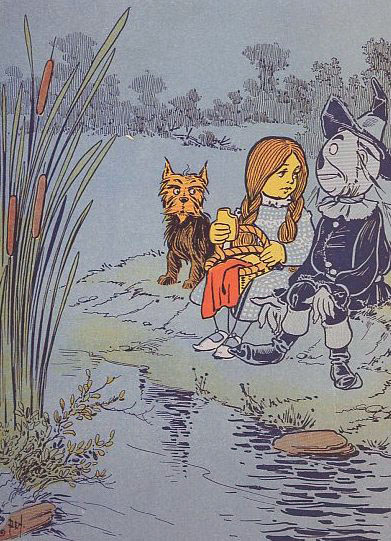Have you ever noticed that when Dorothy says, “There’s no place like home,” she’s eating a picnic lunch?
Dorothy has just left Munchkin Country and is on her way to the Emerald City of Oz in the company of the Strawman. Though her meal is a meager sandwich, Dorothy does not complain and even offers Scarecrow a share. Baum employs this genuinely kind-hearted gesture to establish Dorothy’s good nature as a character-building model without heavy-handed pedagogy.
Dorothy and the Scarecrow sit side-by-side, and when he refuses the sandwich, it’s because he does not need to eat. He says, “For my mouth is only painted.” Dorothy is secretly pleased because there isn’t much bread after feeding herself and Toto. Dorothy’s basket is wicker covered with red cloth. She drinks the clear local water from a spring, of course.
Denslow’s illustration for the first edition is faithful to Baum’s text but adds some necessary details—the blue water in the stream fringed with cattails and a patch of green grass.
Victor Fleming’s 1939 film The Wizard of Oz omits Baum’s picnic episode.
See L. Frank Baum. The Wonderful Wizard of Oz. Translated by Illustrations by W. W. Denslow, Edited by illus. W.W. Denslow. Chicago: George M. Hill, 1900. Reprint, 1960; Victor Fleming. The Wizard of Oz (1939). Screenplay by Noel Langley, Florence Ryerson, and Edgar Allan Woolf is based on L. Frank Baum’s novel (1900)

